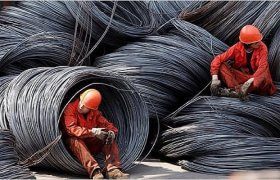The Chinese government has always been a major culprit in environmental pollution in the international community. This has caused billions of dollars in annual damage to the country’s infrastructure and environment. This has led China to take a tougher line on environmental issues this year. So much so that in recent days, talk of reduce the volume of steel production and closing down polluting factories in this country has been introduced as the main subjects of news agencies. We will discuss this issue in more detail below. Please be with Artan Press.
*** The paradox is the decline in Chinese steel production and the boom in the global economy
Economists are looking at the global economic recovery that seems to be taking shape as commodity prices seek to improve demand after the corona epidemic, escalating tensions between China and Australia, and supply-side issues. Are located at the top. Many factors in the world have come together to see prices rise. But in such a situation, China is thinking about more important issues than price growth. The environmental crisis in this country is a serious issue and is considered as the biggest threat to the country’s economy. So the Chinese have decided to pay as much attention to the environmental crisis as the US sanctions scenario.
*** Environmental reform; China aims to reduce steel production
Last week, iron ore broke the record of nearly $ 238, and earlier this month, copper prices broke the record of the last decade. Economic stimulus support packages added a new layer to the growth of global demand while the foundations of the world’s commodity markets themselves were strong and growing. In such circumstances, China is thinking of reforming its environmental infrastructure and controlling pollution in its country. Some official news outlets have reported that in China from May 1, import tariffs on crude iron, crude steel, scrap and other steel goods to zero it is arrived. It seems that China seeks to change the production structure of its country and impose pollution costs on other producing countries.
*** China aims to reduce domestic steel production
But the main question is why China has decided to withdraw from the production of some steel items in the current situation where the global steel markets are at the highest rate of return? This increase in prices has led some to believe that the world’s commodity markets are entering a new supercycle, which means that prices will rise for at least several years. The example of this predominantly Chinese supercycle can be seen in the years 2002 to 2008, when in this country, with the industrialization and urbanization boom, China’s GDP had a favorable and increasing annual growth.
In fact, Commodities have experienced four supersycles in the last hundred years, the last one being in 2008. But it seems that in the current situation, the playing field has changed. China’s main reasons for adopting this approach can be summed up in reducing import costs, increasing steel imports, supporting domestic producers to reduce crude steel production, leading the industry to reduce energy consumption and pressure on industrial upgrades, and developing high quality steel. .
*** China relies on economic growth in 2020
China was one of the few countries to experience acceptable economic growth in 2020. Due to the closure of the country’s environmental regulatory bodies, it started producing crude steel as much as it could afford. In 2020, China’s steel production jumped 5.2 percent from a year earlier, while global production fell 0.9 percent. Its share of the global steel market rose to 57.5 percent.
Thus, it can be argued that China, thanks to its economic growth in 2020 and mass production of steel at a time when many industries in the world were shut down, was able to create an environmentally safe margin for itself. It is time for China’s warehouses to be replenished by manufacturers such as Iran. Because China can not tolerate environmental risks at a time when the US-China rivalry has reached its most critical stages.
*** The serious determination of the Chinese to reduce steel production of polluting industries
China’s steel mills are responsible for about 15 percent of the country’s carbon emissions and more than 60 percent of the world’s steel emissions. By imposing these restrictions on China’s steel production, the country is effectively blocking the US from imposing environmental sanctions on its economy. The Sino-US trade war under Biden appears to be more subtle than it was under Trump. In March, officials at the Tangshan City Steel Center in northern Hebei Province threatened to revoke the licenses and licenses of four steel mills because environmental inspectors found they were disobeying orders to stop production when alerting areas for pollution. This shows that China is determined to shut down its polluting industries.
این مطلب بدون برچسب می باشد.












ثبت دیدگاه